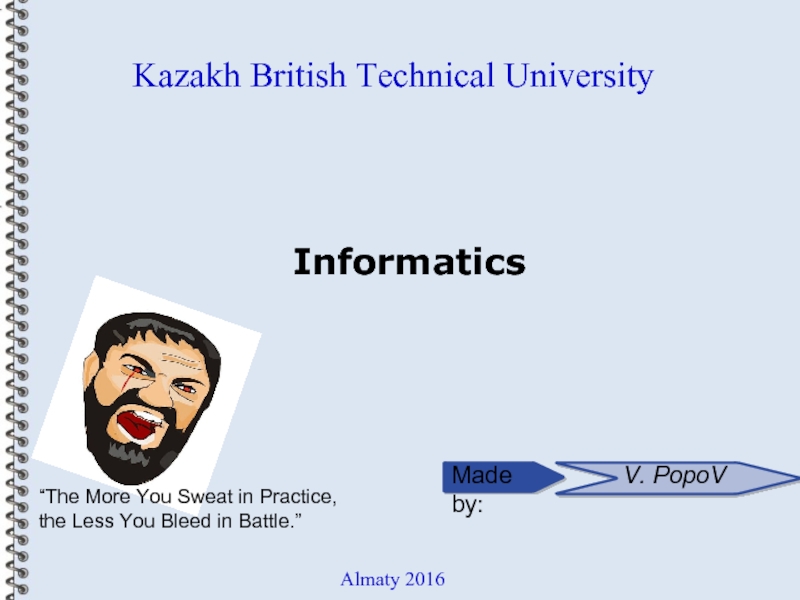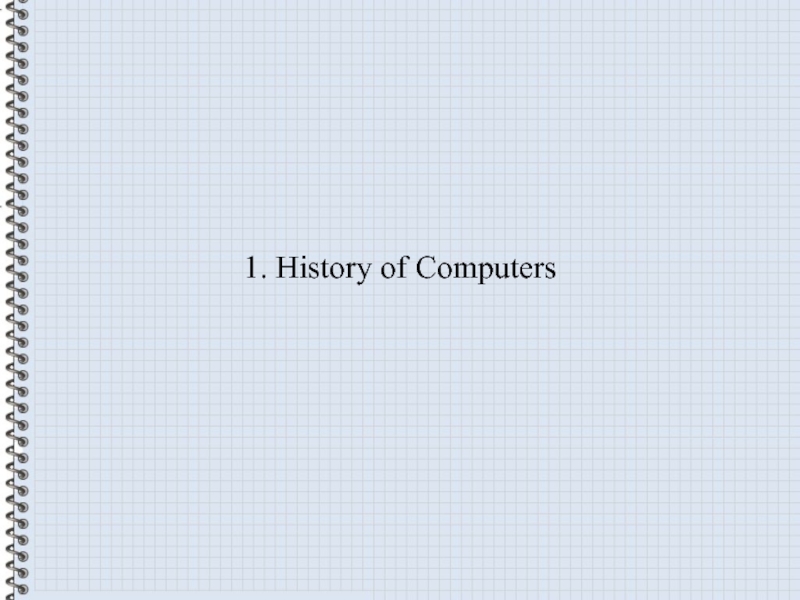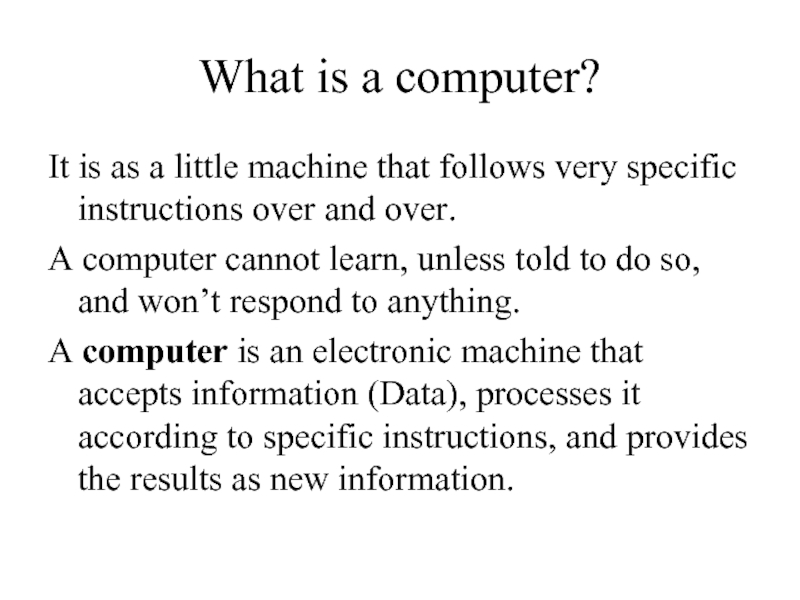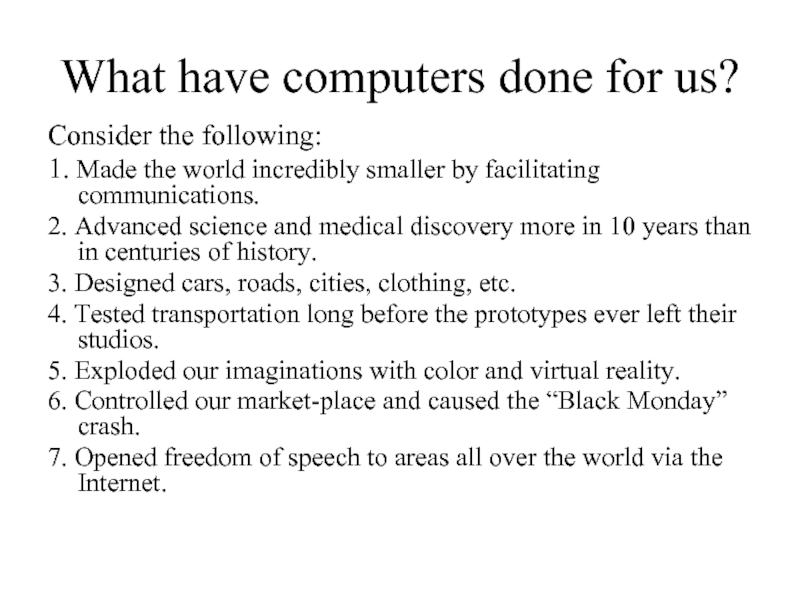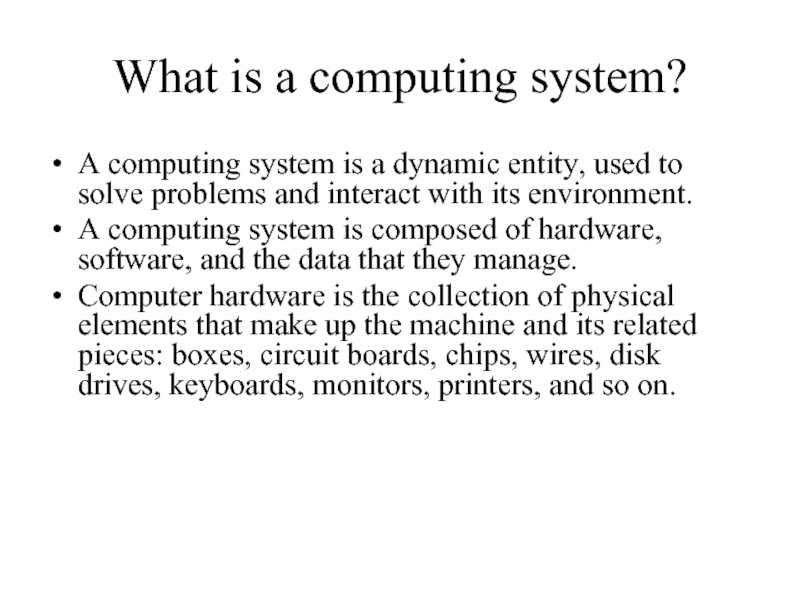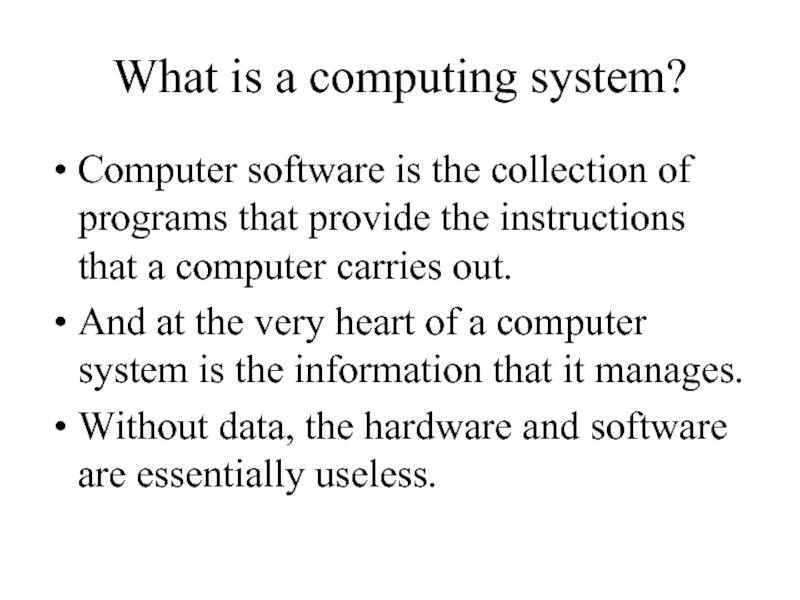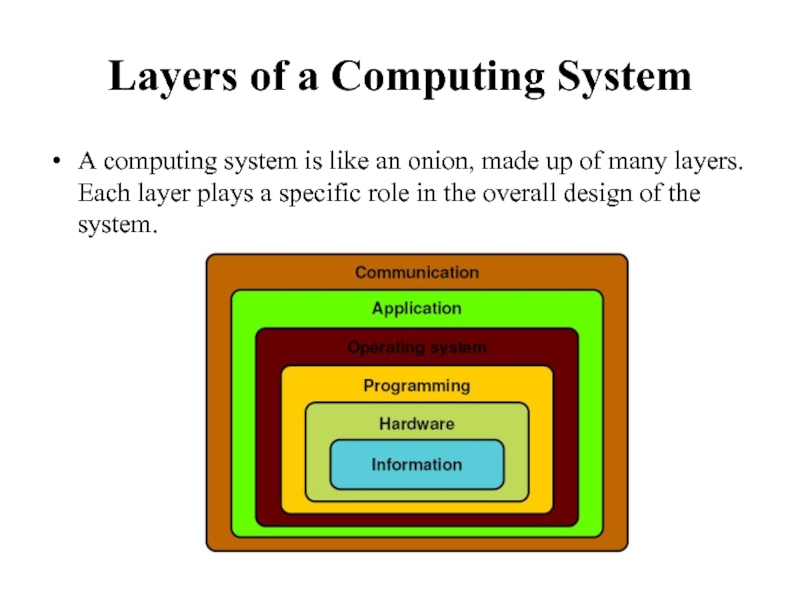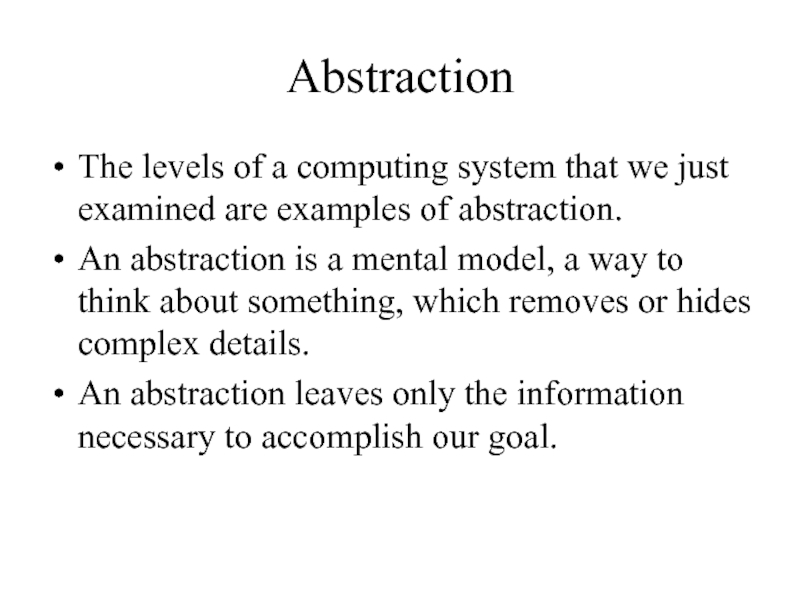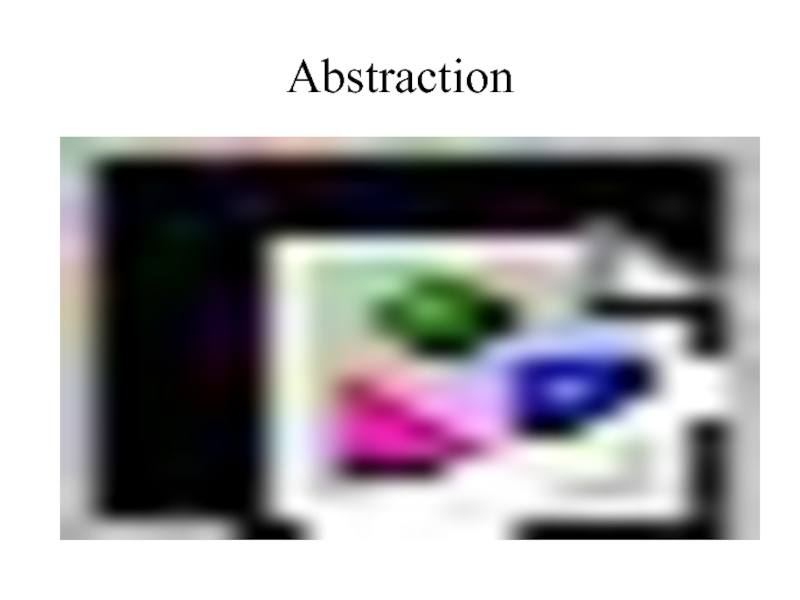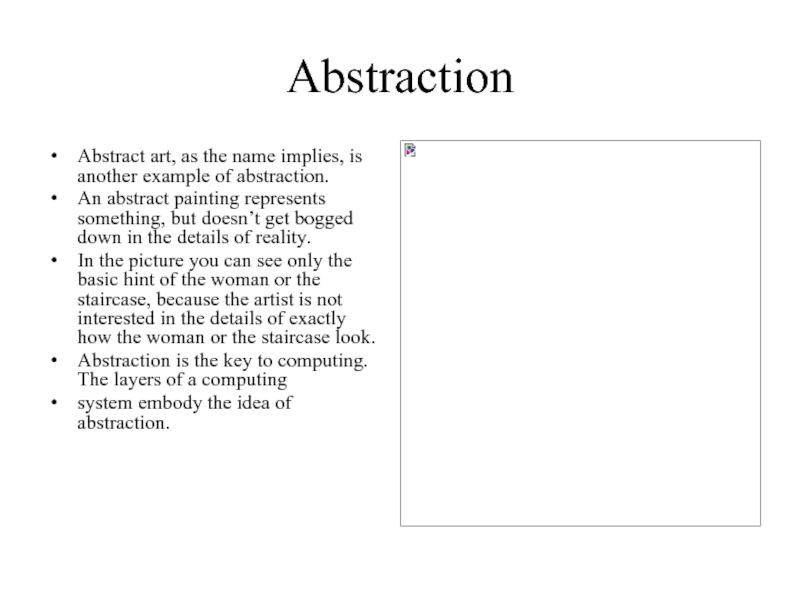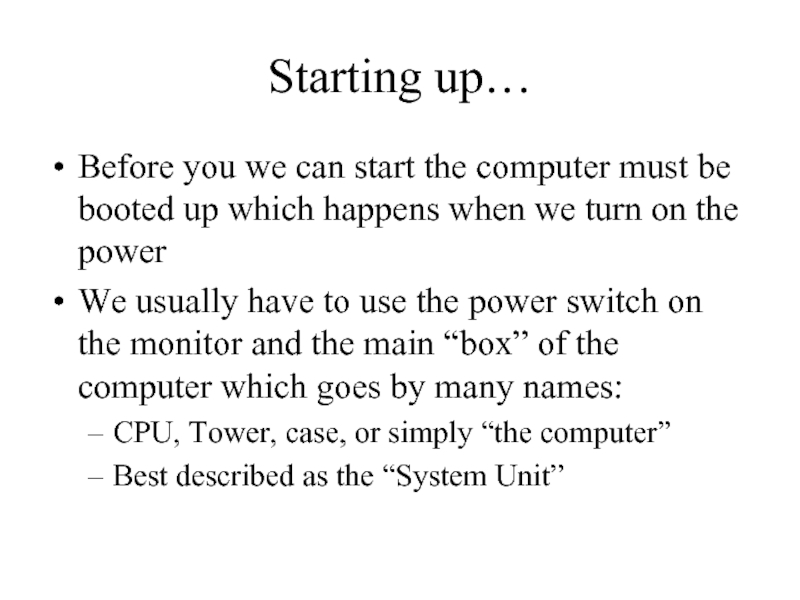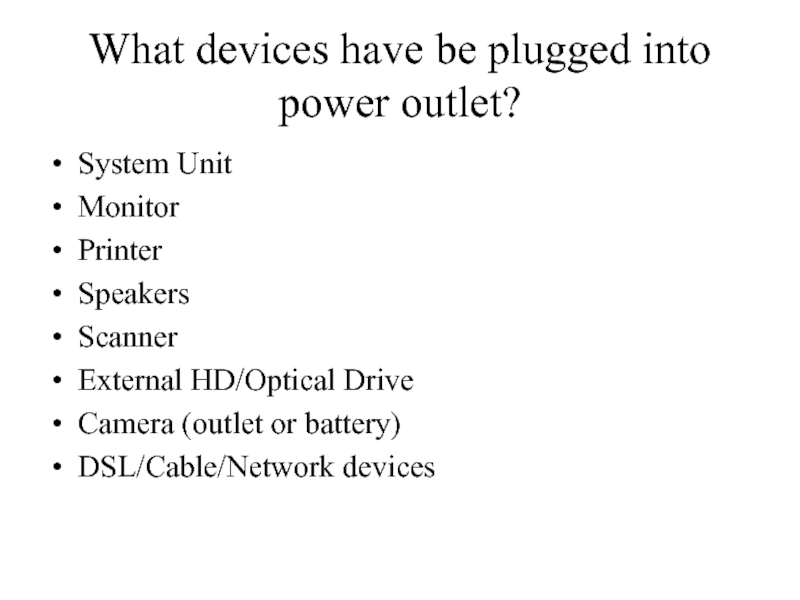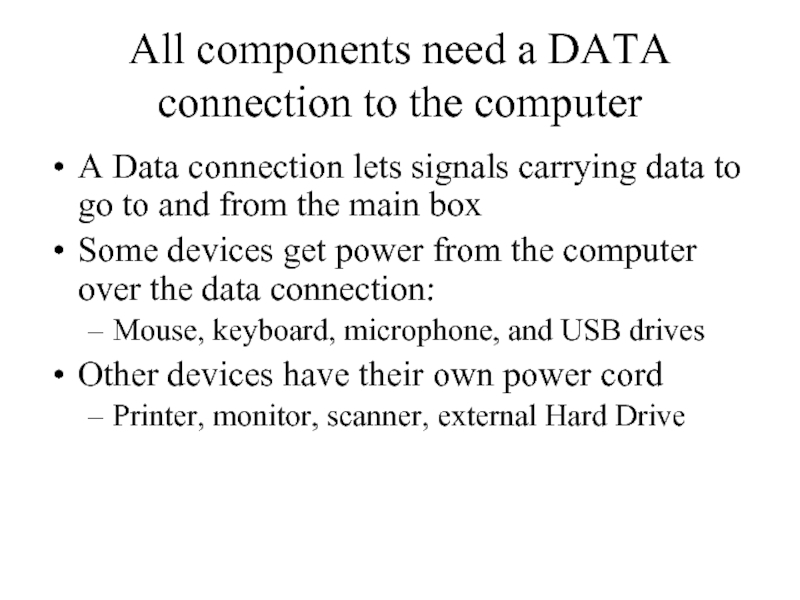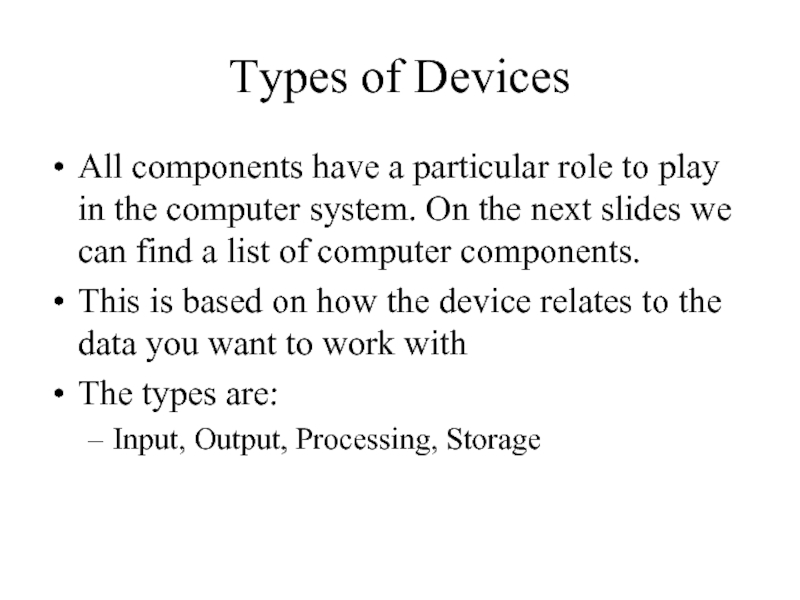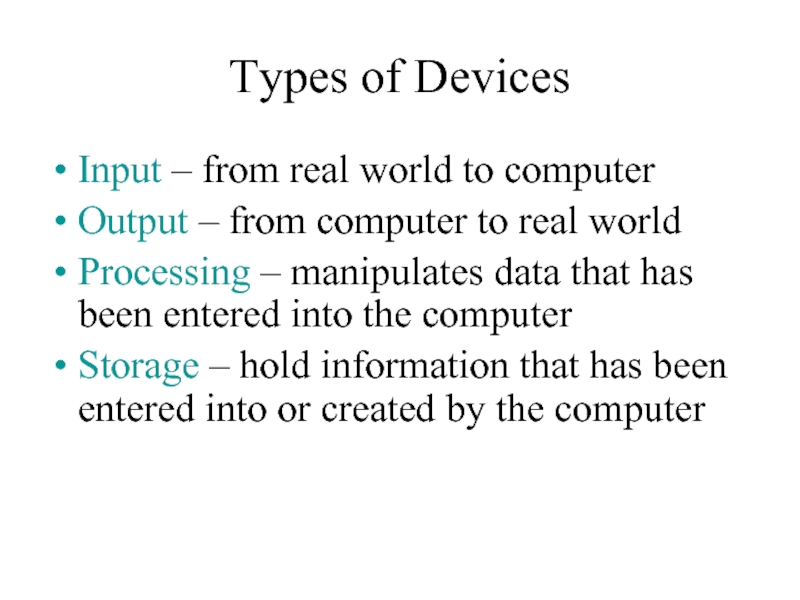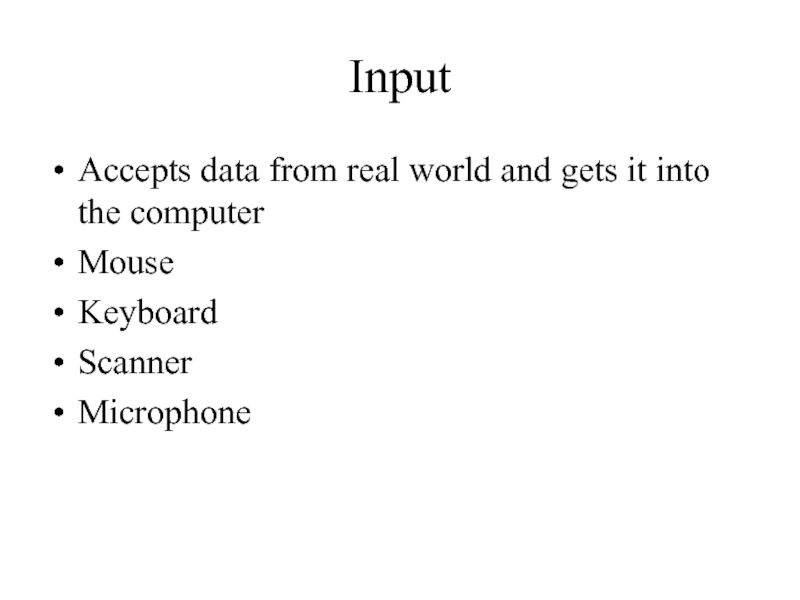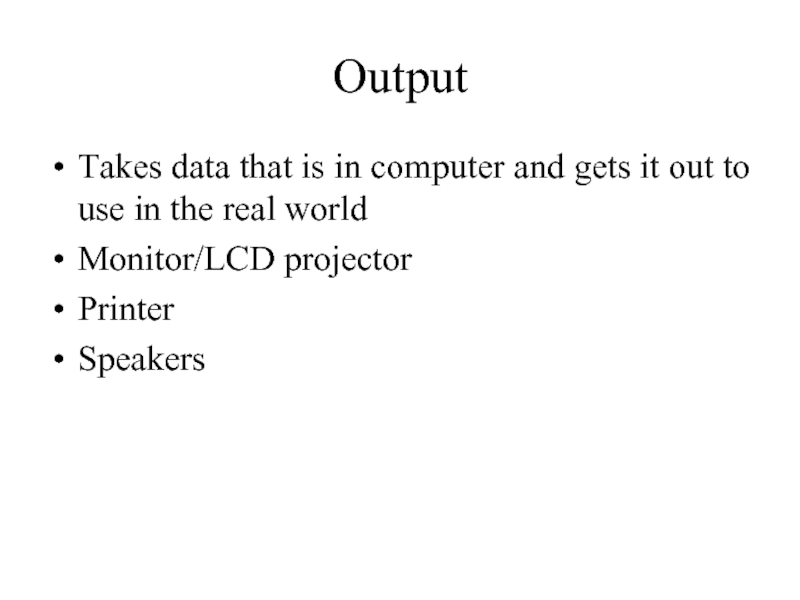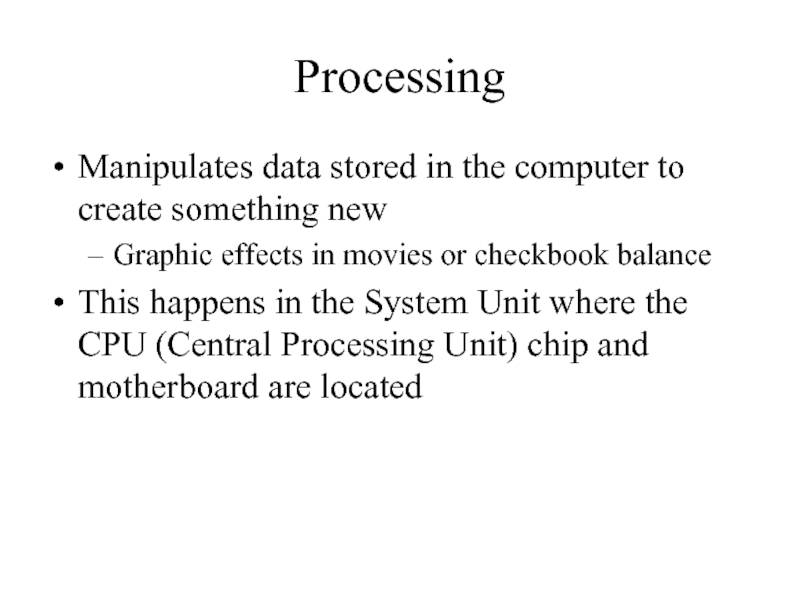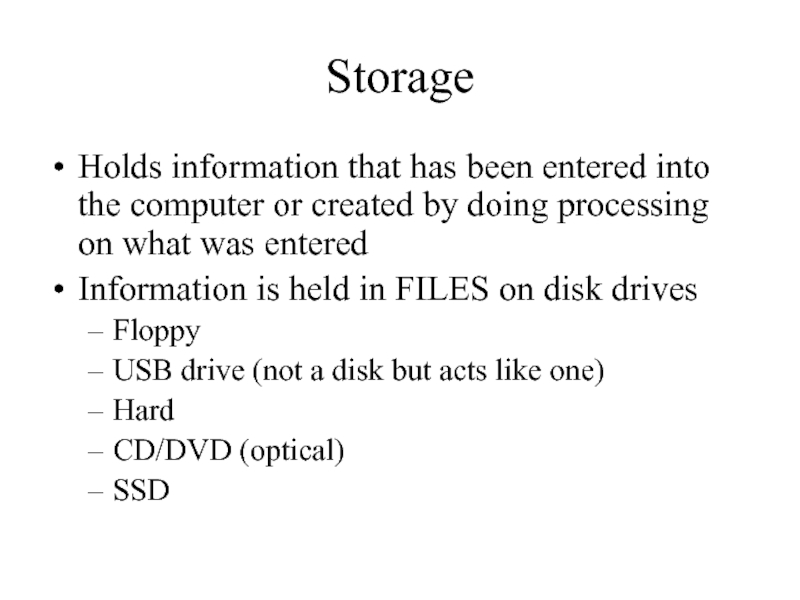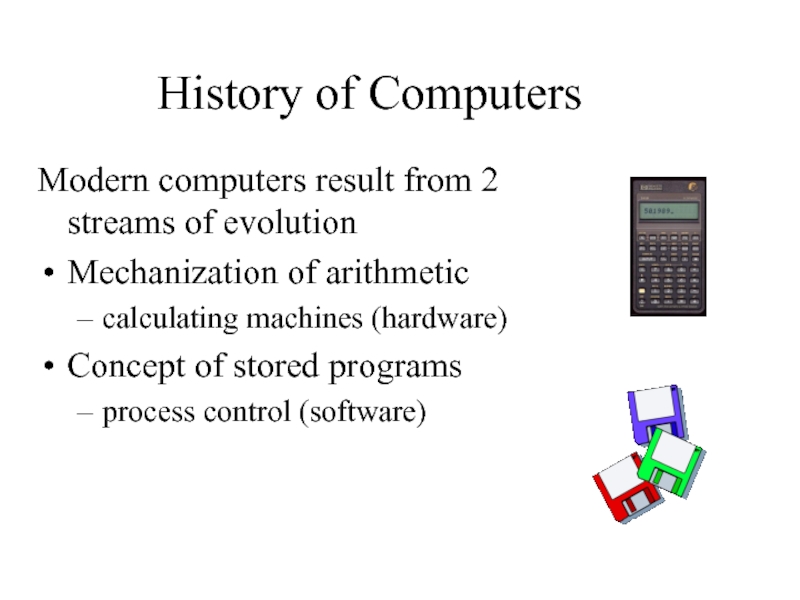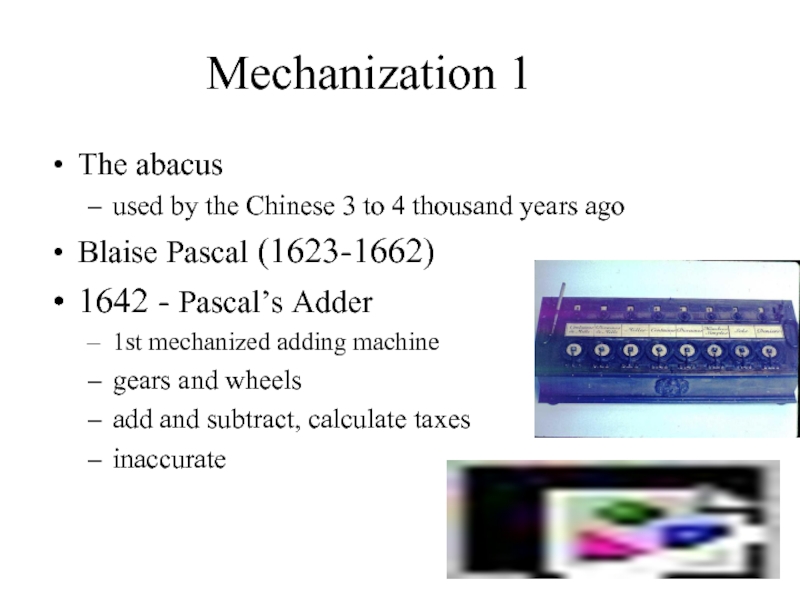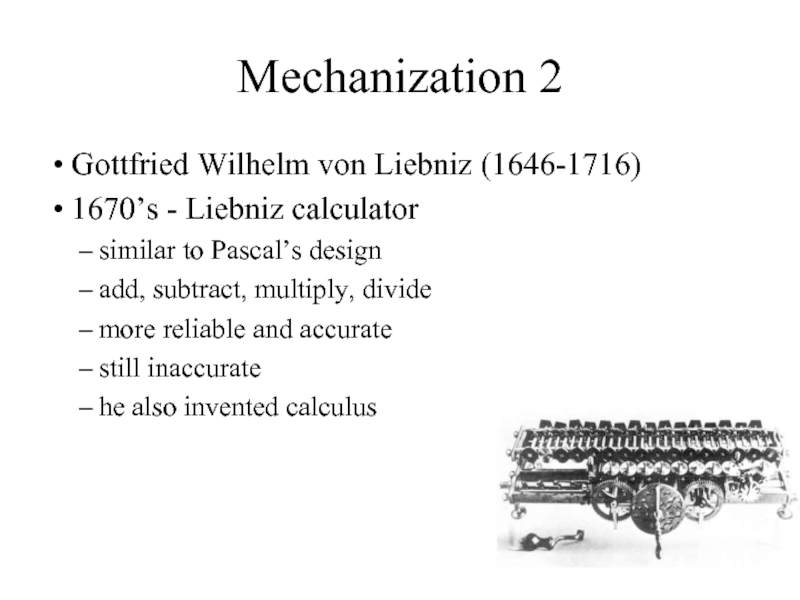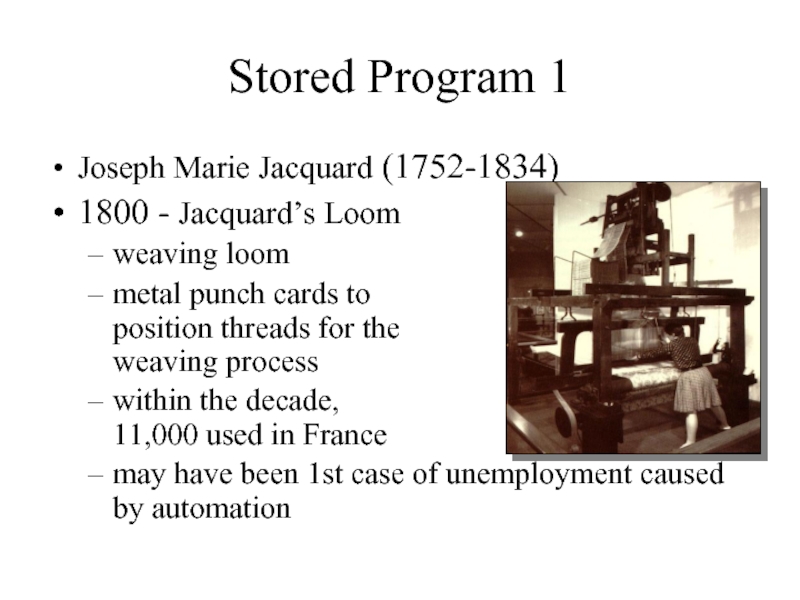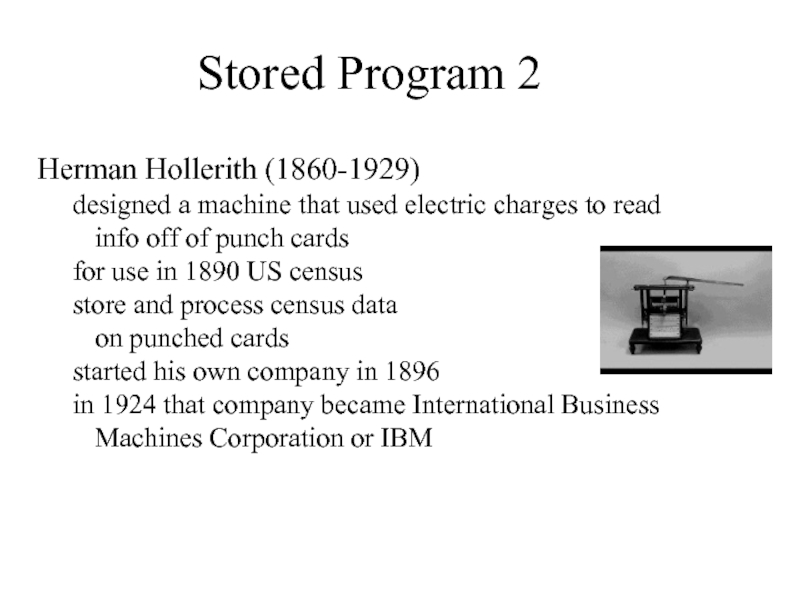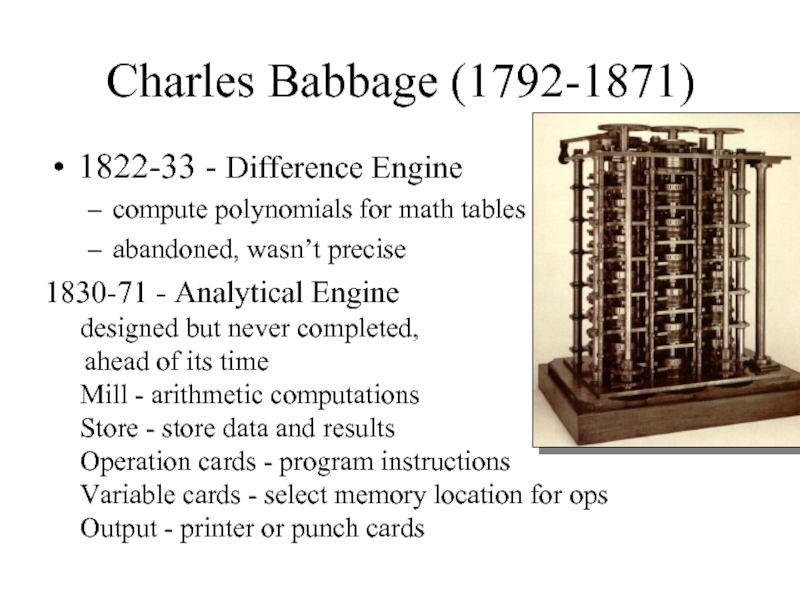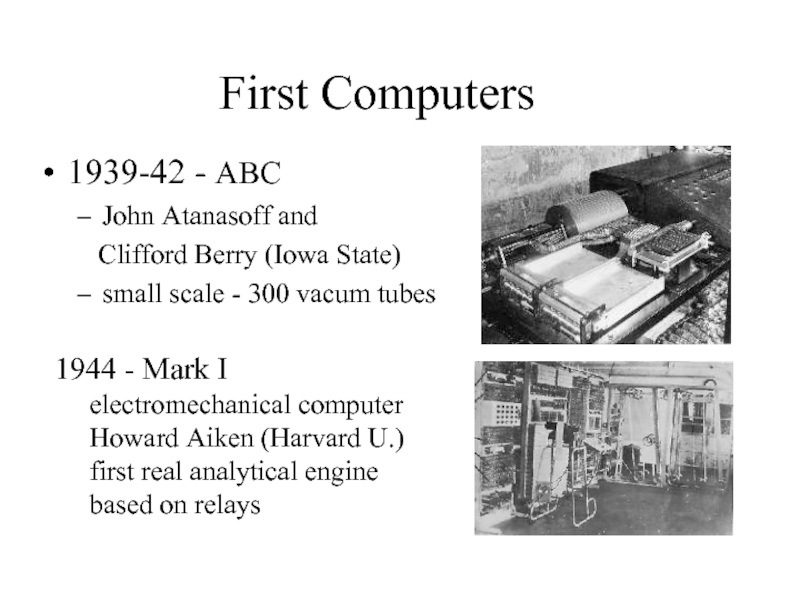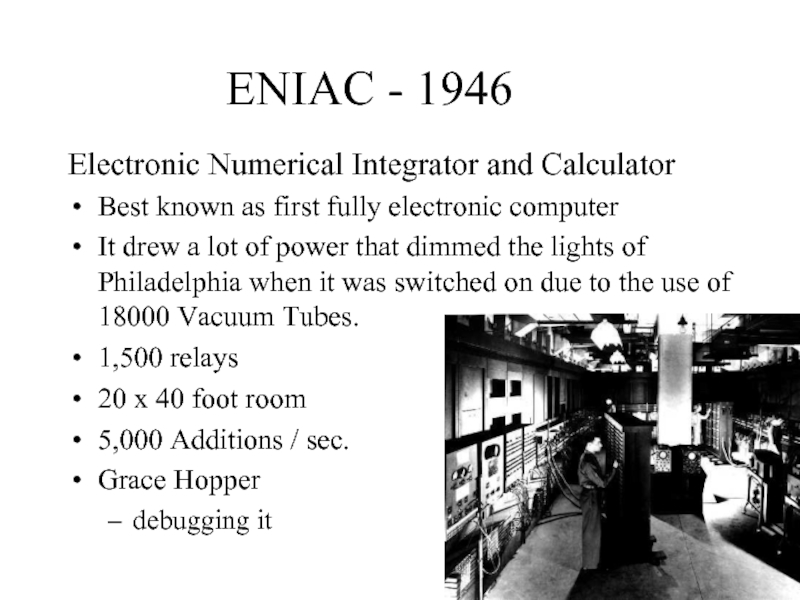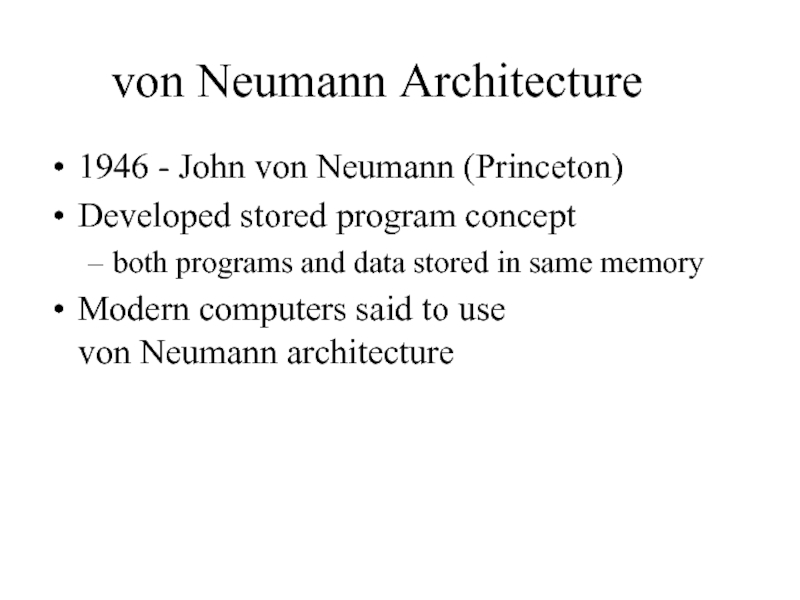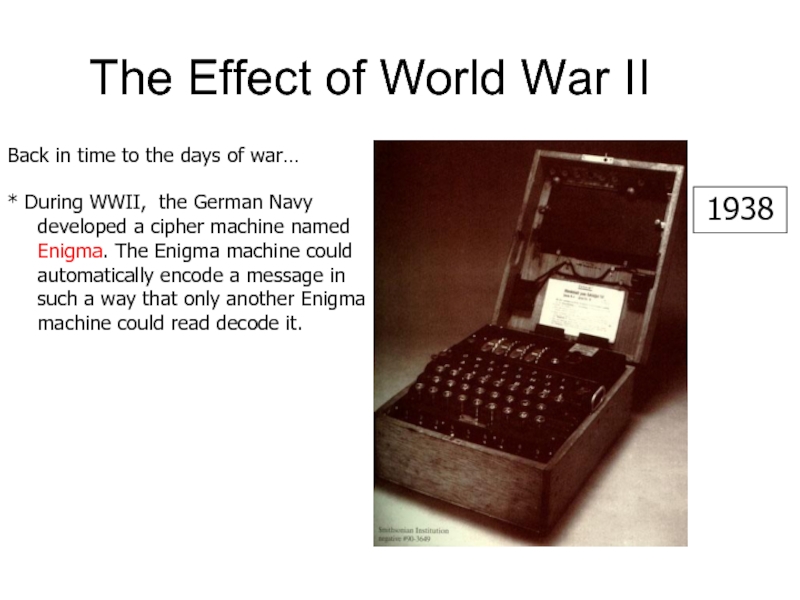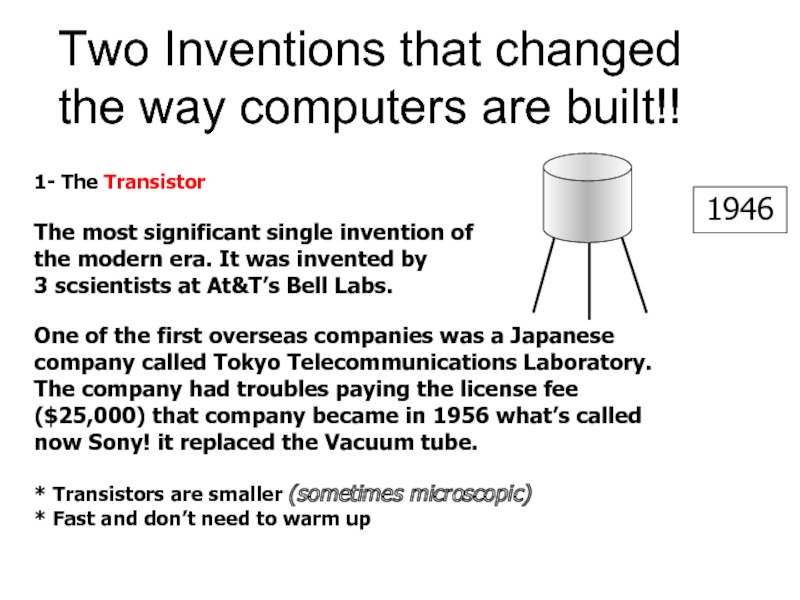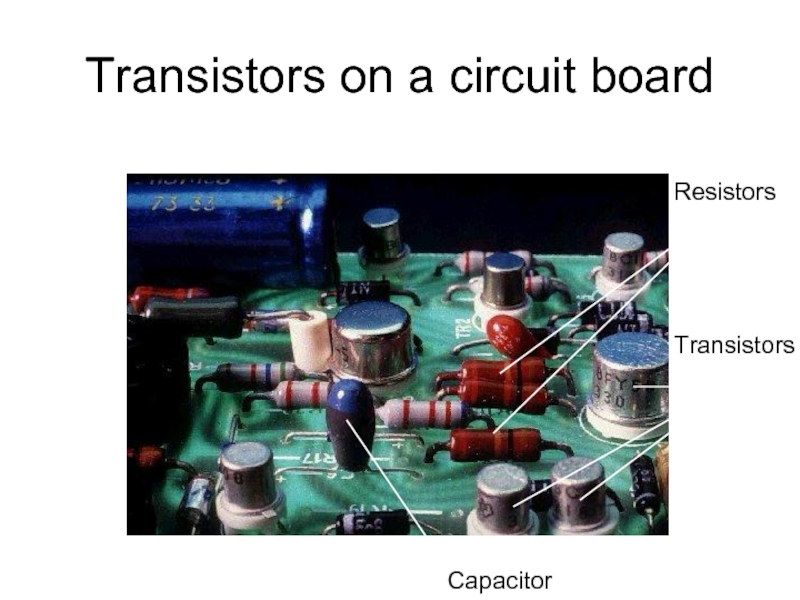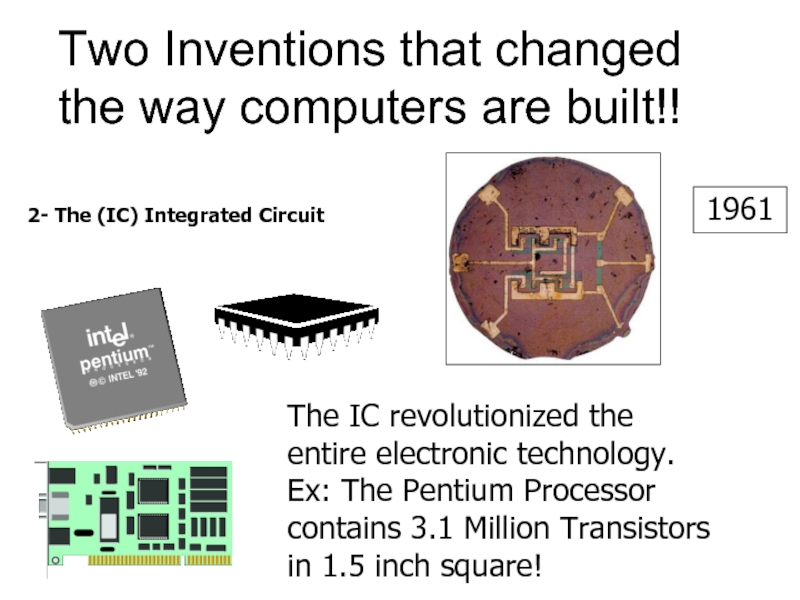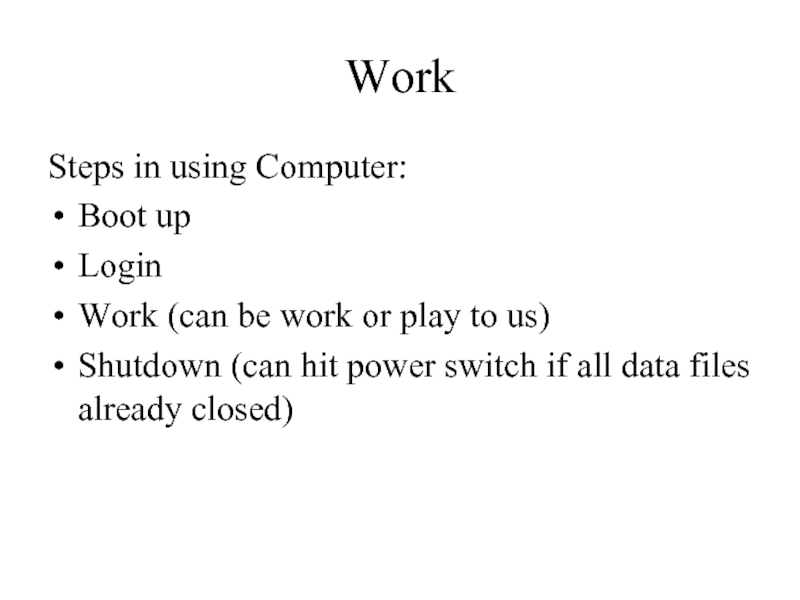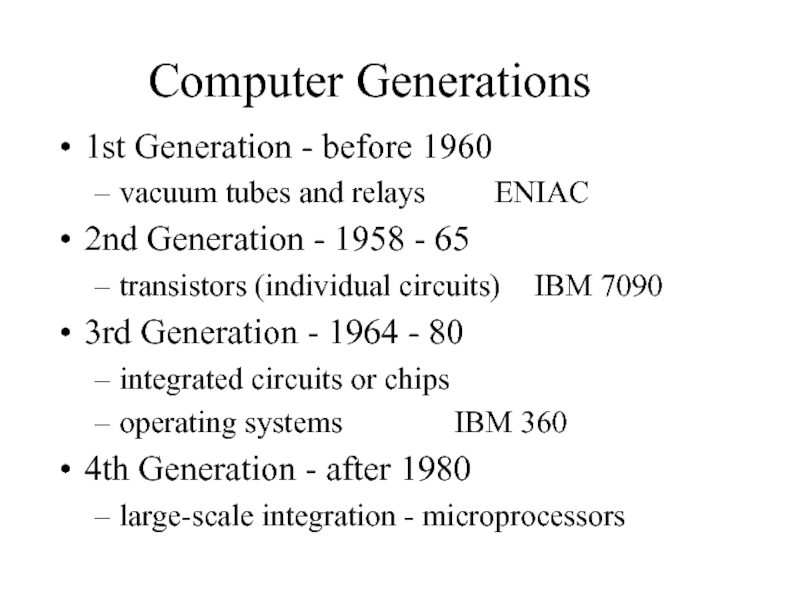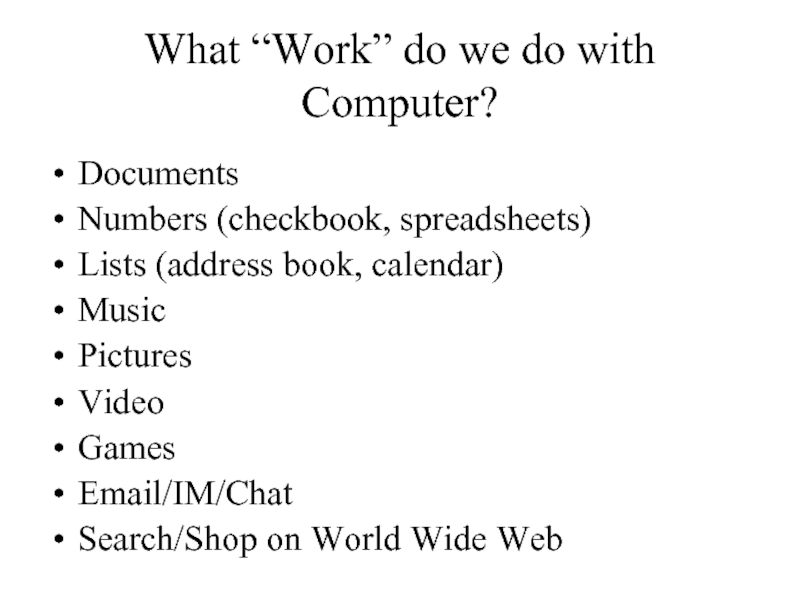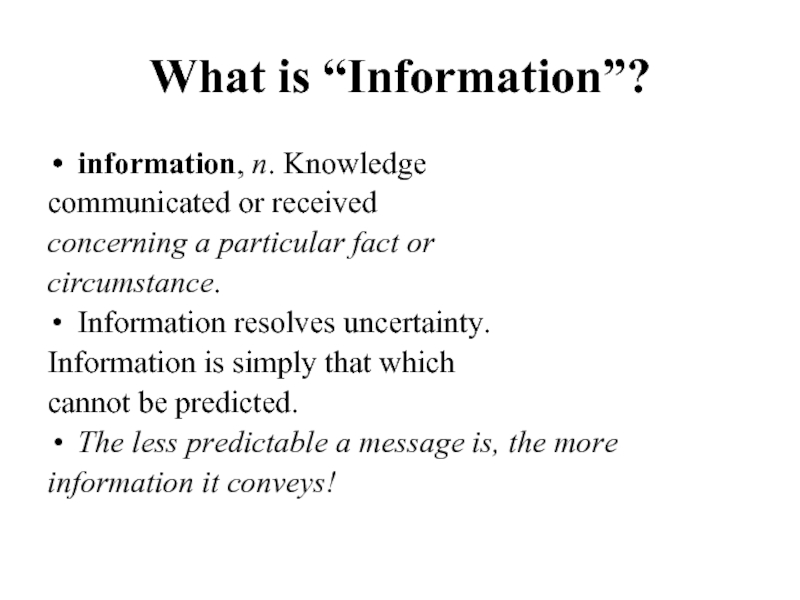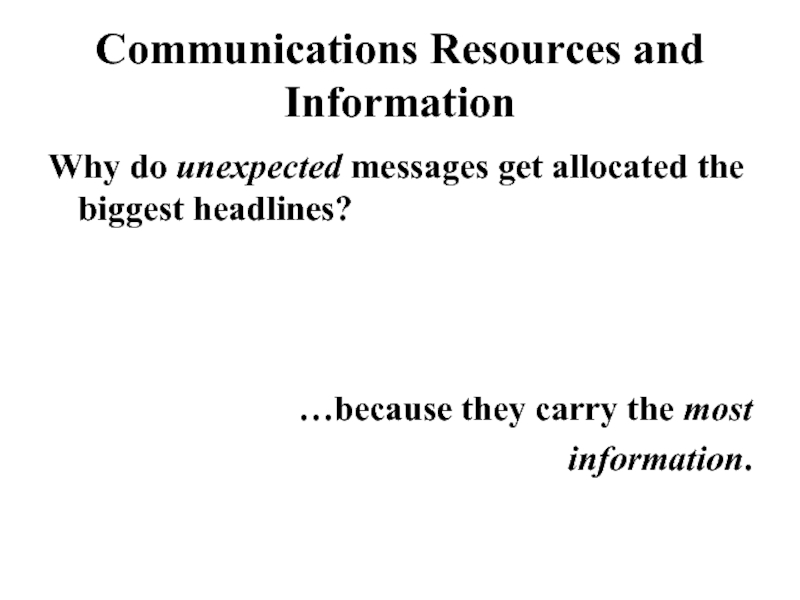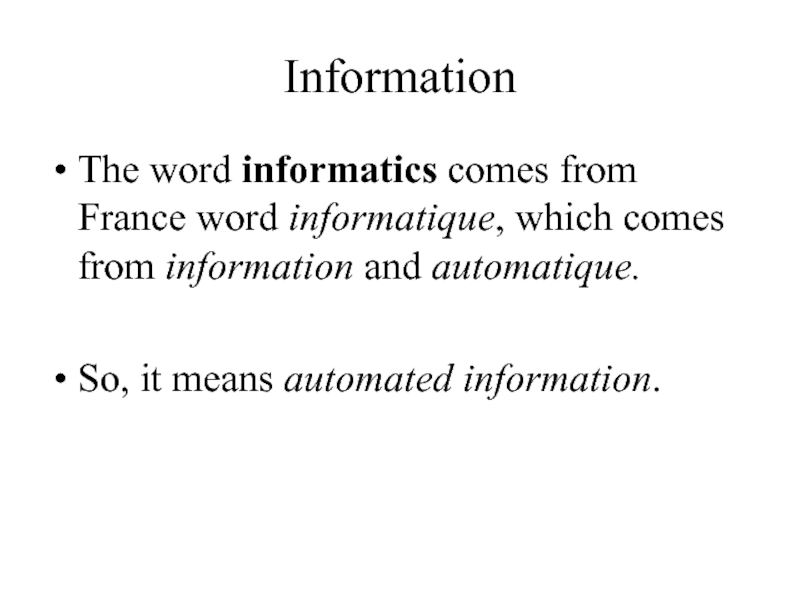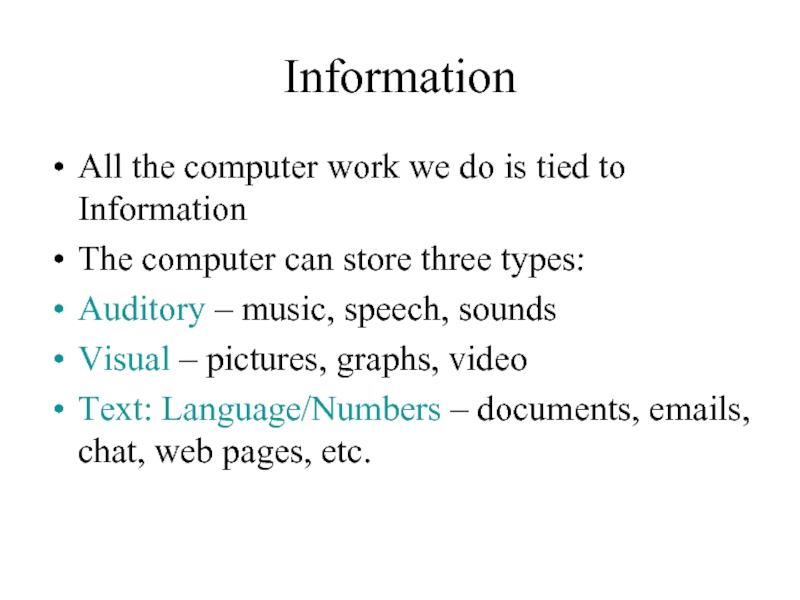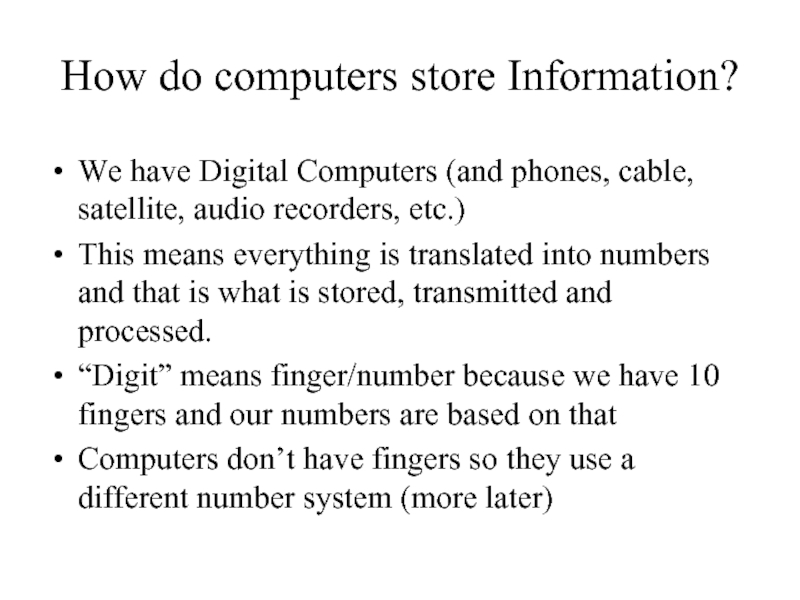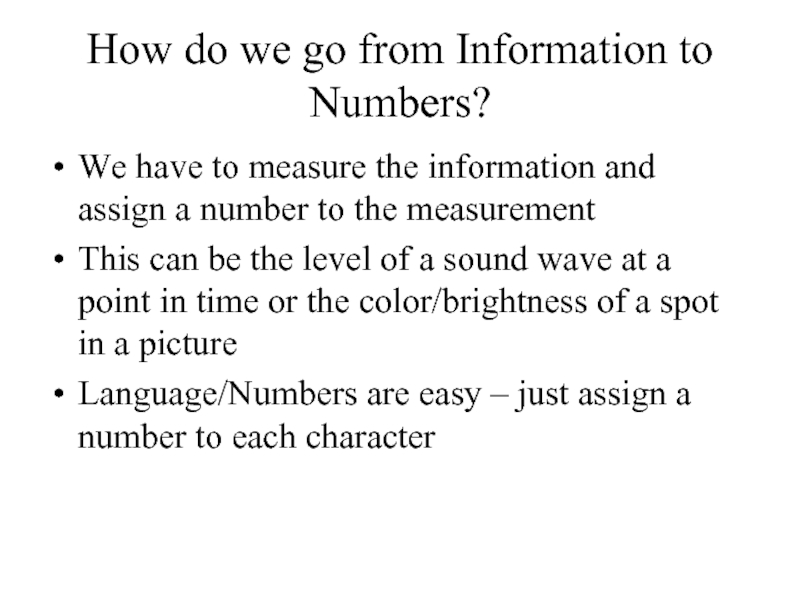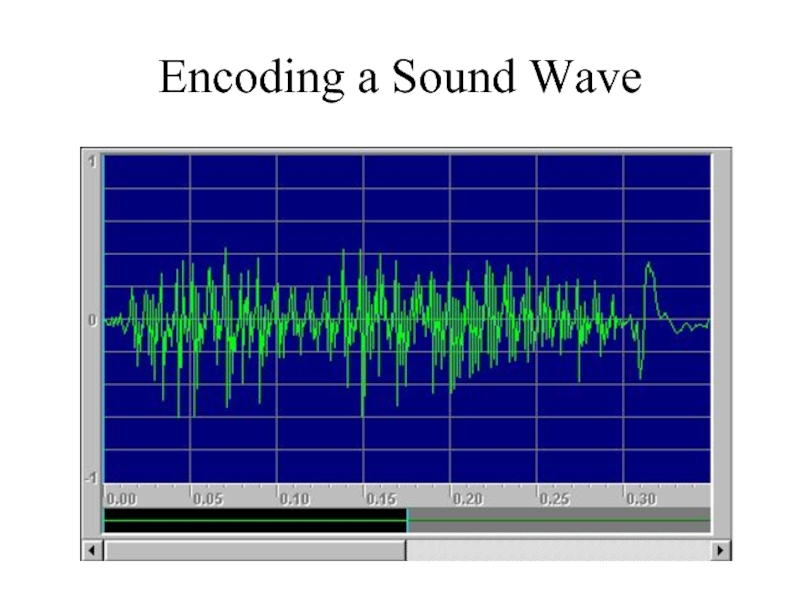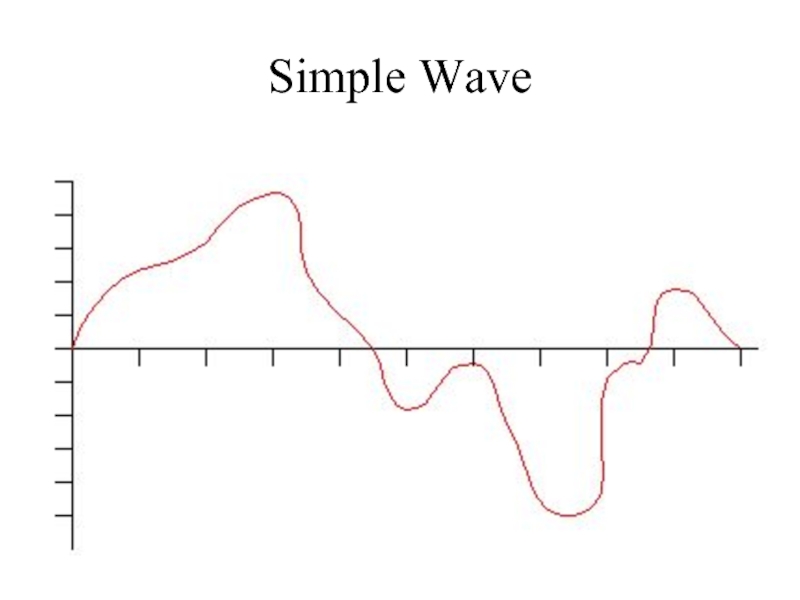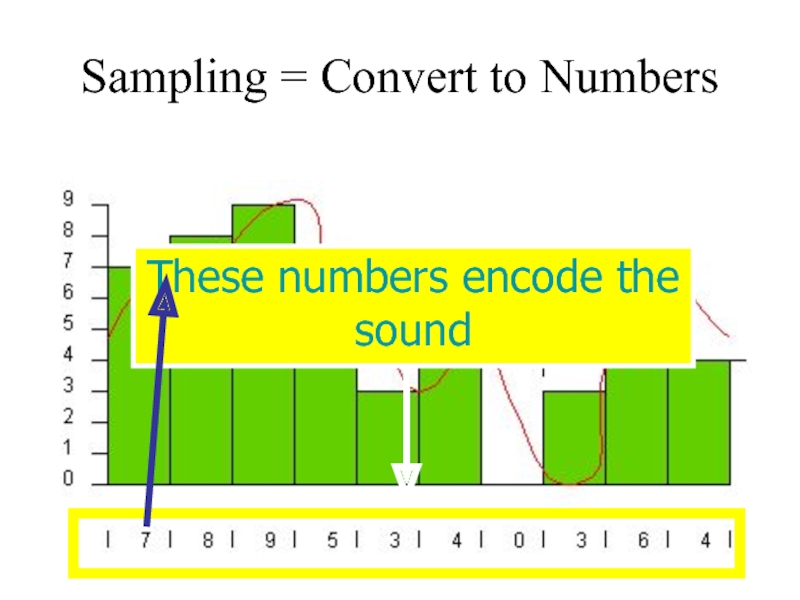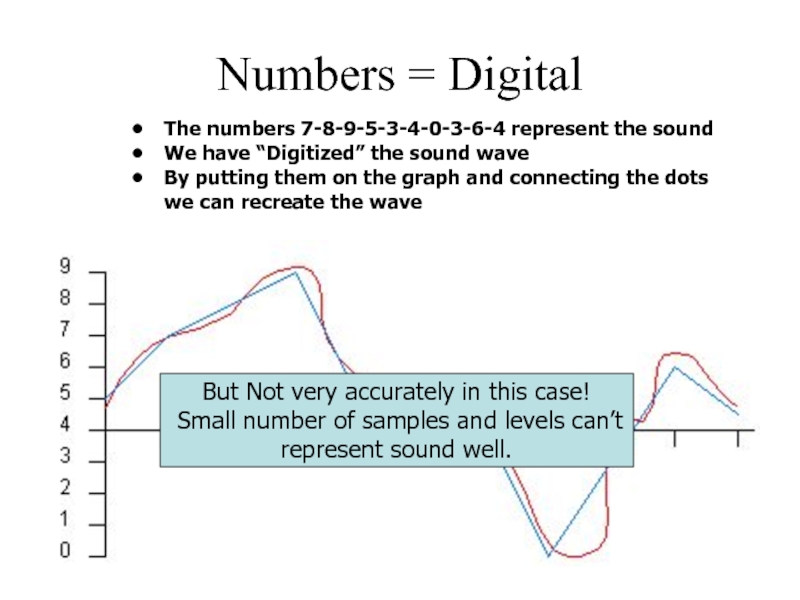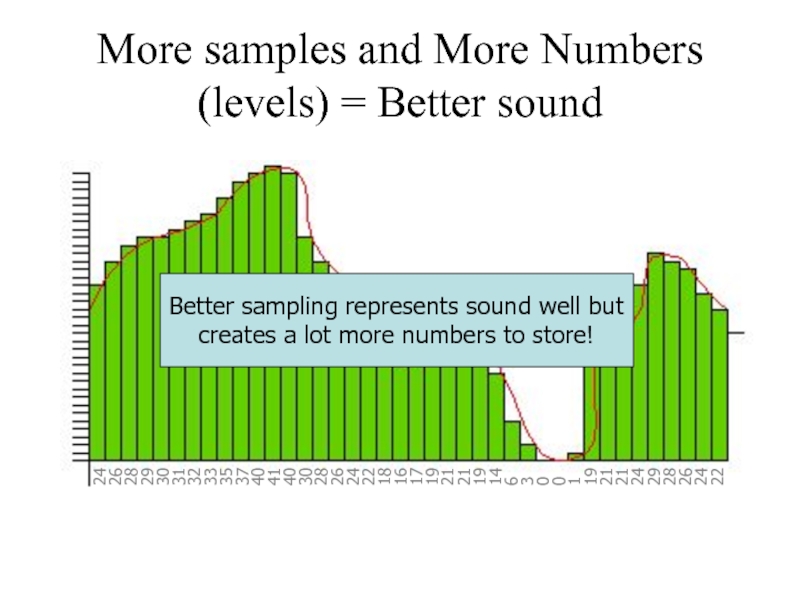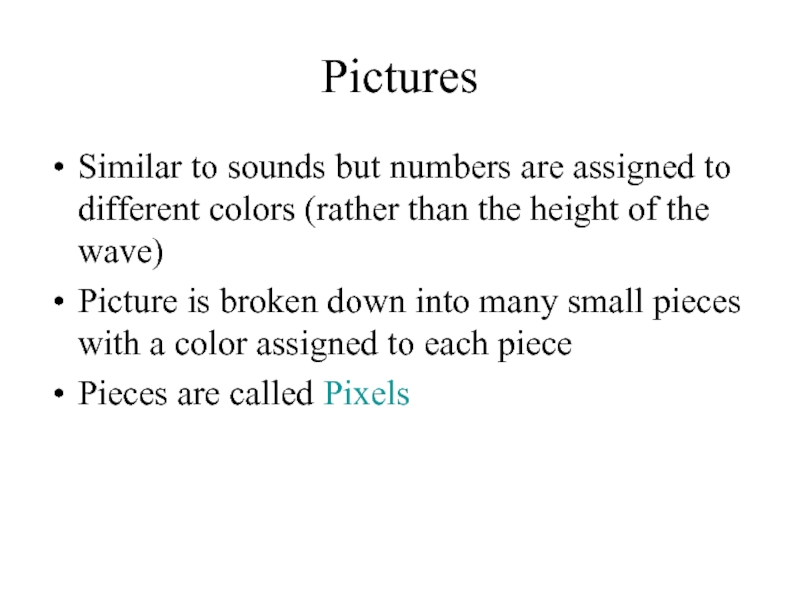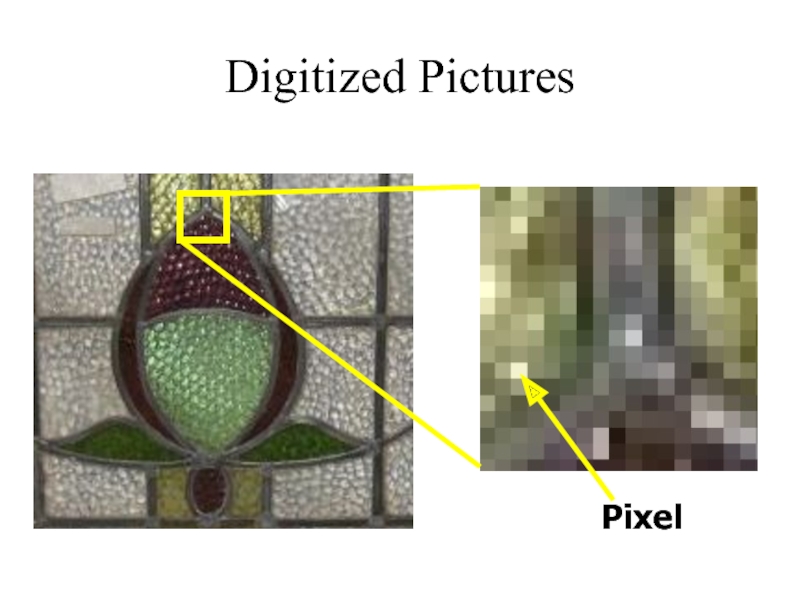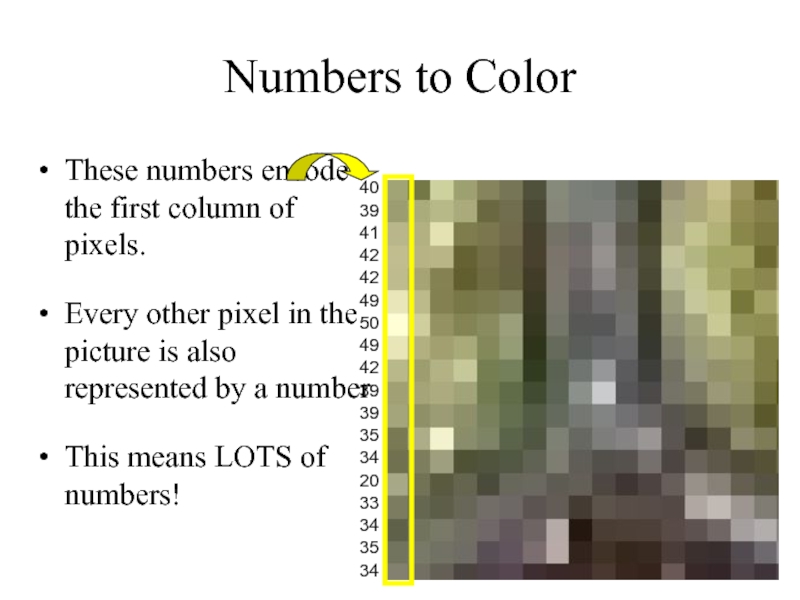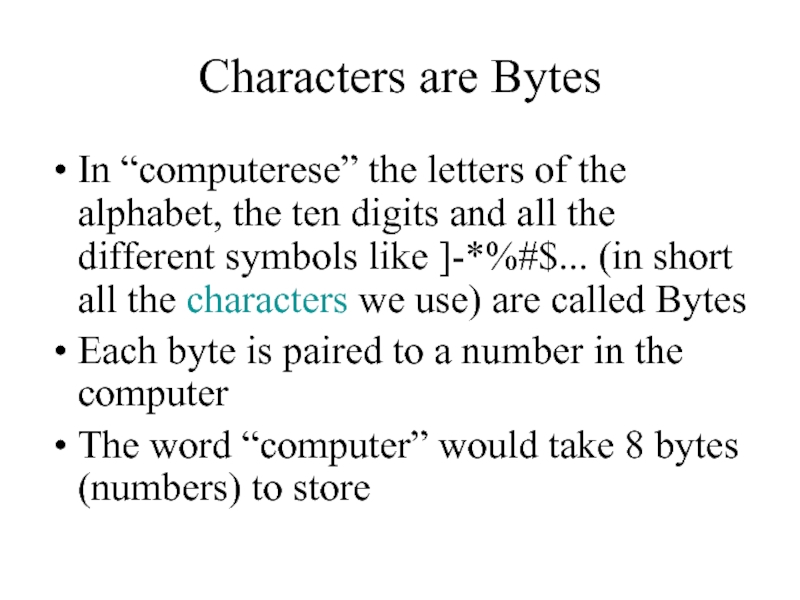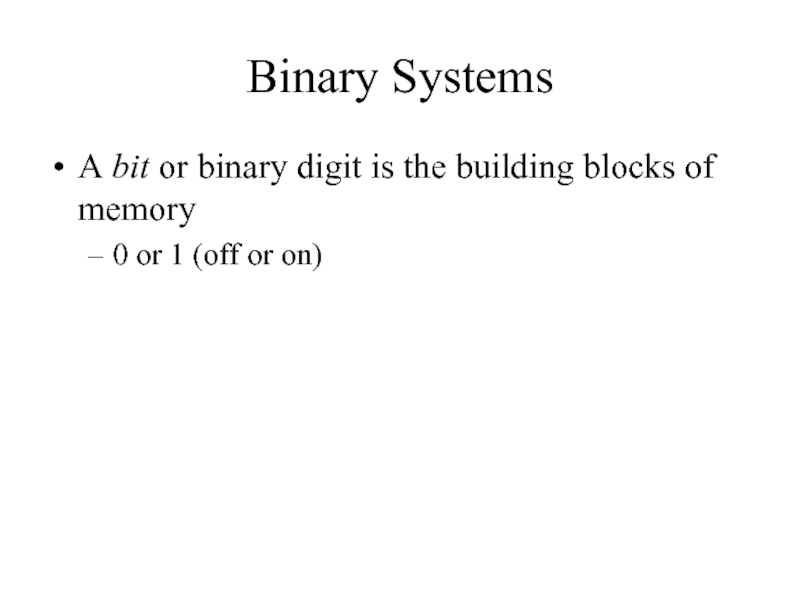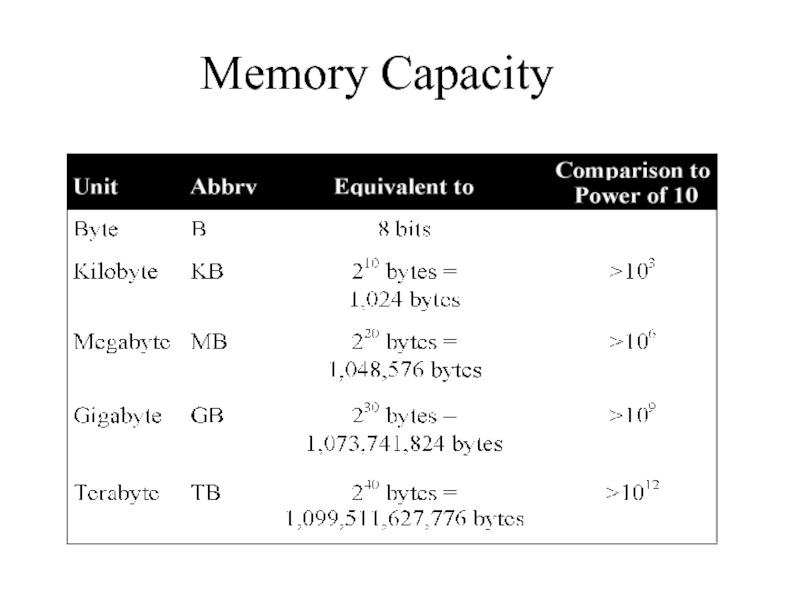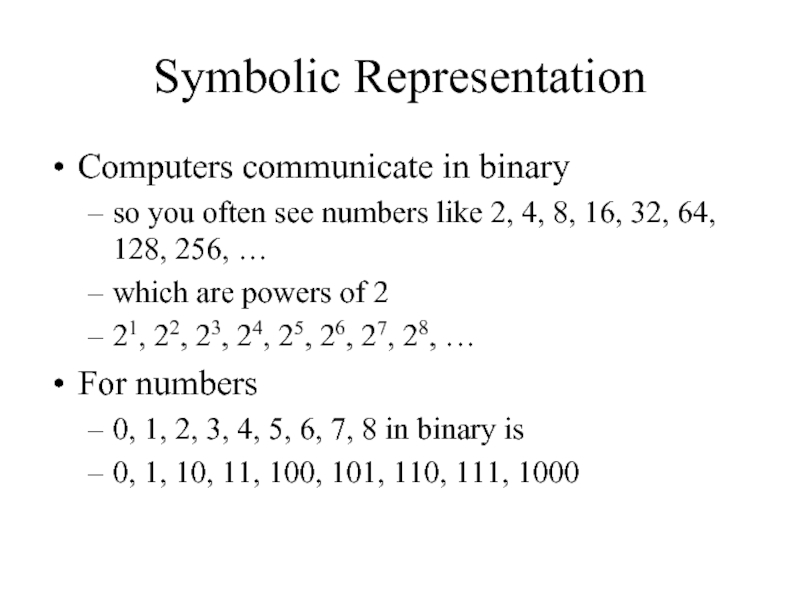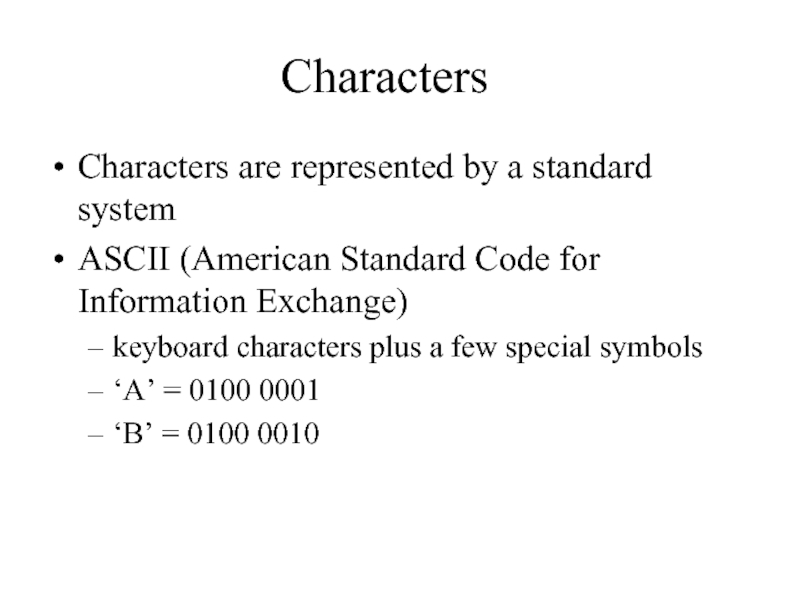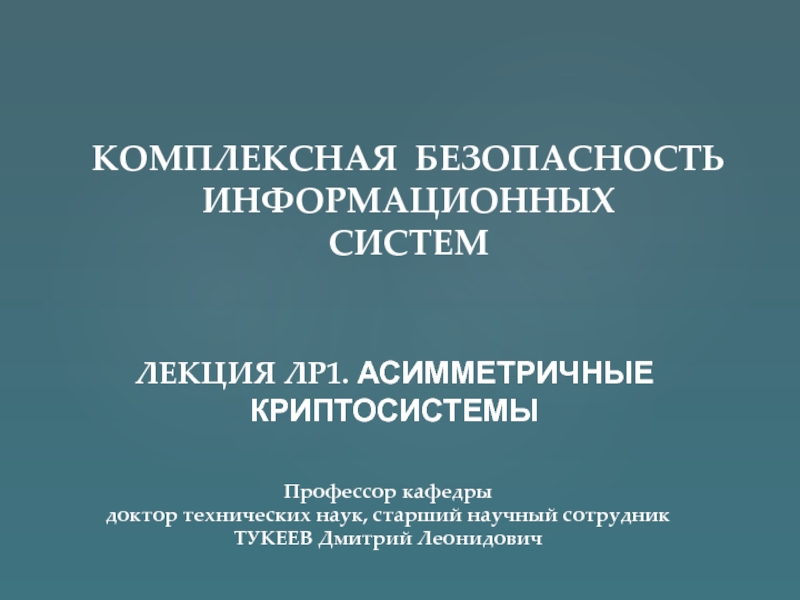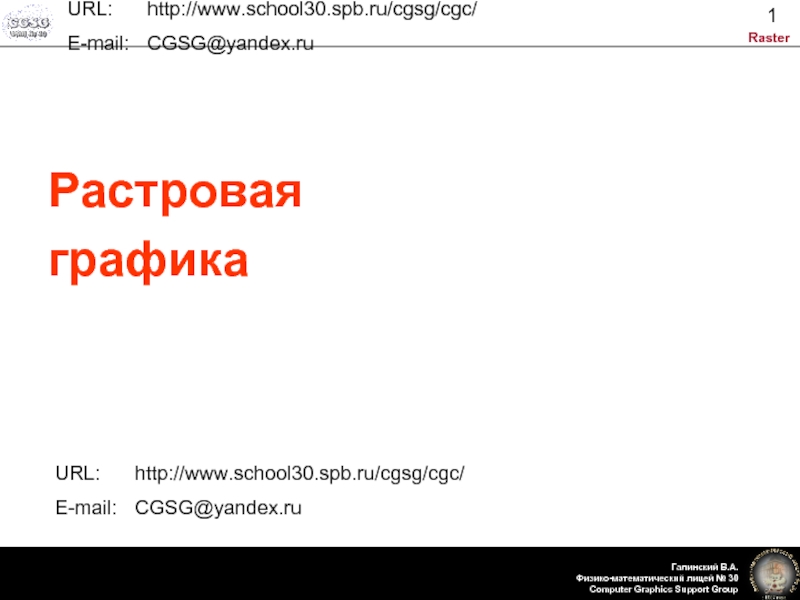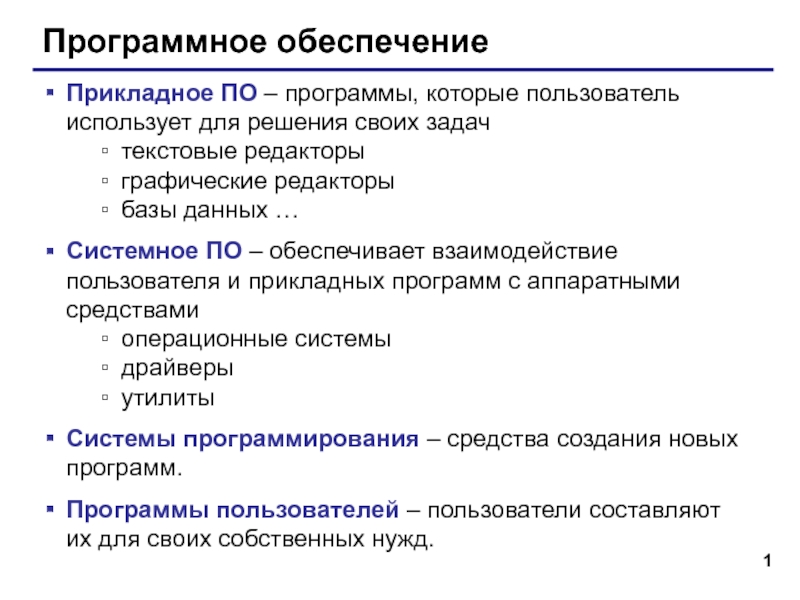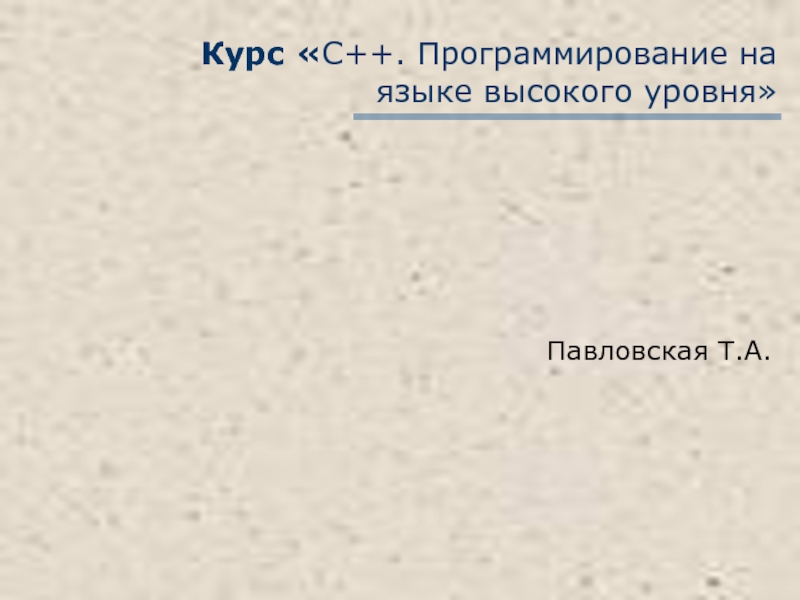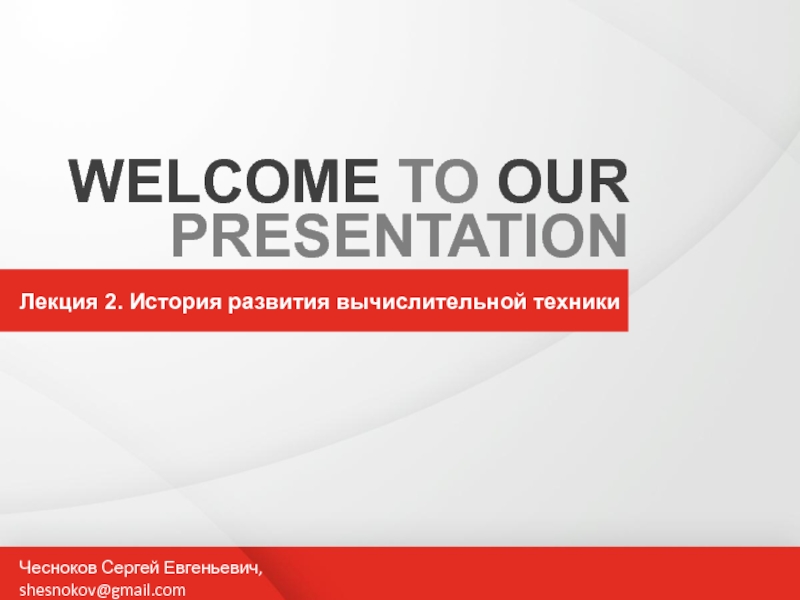- Главная
- Разное
- Дизайн
- Бизнес и предпринимательство
- Аналитика
- Образование
- Развлечения
- Красота и здоровье
- Финансы
- Государство
- Путешествия
- Спорт
- Недвижимость
- Армия
- Графика
- Культурология
- Еда и кулинария
- Лингвистика
- Английский язык
- Астрономия
- Алгебра
- Биология
- География
- Детские презентации
- Информатика
- История
- Литература
- Маркетинг
- Математика
- Медицина
- Менеджмент
- Музыка
- МХК
- Немецкий язык
- ОБЖ
- Обществознание
- Окружающий мир
- Педагогика
- Русский язык
- Технология
- Физика
- Философия
- Химия
- Шаблоны, картинки для презентаций
- Экология
- Экономика
- Юриспруденция
Informatics. History of computers презентация
Содержание
- 1. Informatics. History of computers
- 2. 1. History of Computers
- 3. What is a computer? It is as
- 4. What have computers done for us? Consider
- 5. What is a computing system? A computing
- 6. What is a computing system? Computer software
- 7. Layers of a Computing System A computing
- 8. Abstraction The levels of a computing system
- 9. Abstraction
- 10. Abstraction Abstract art, as the name implies,
- 11. Starting up… Before you we can start
- 12. What devices have be plugged into power
- 13. All components need a DATA connection to
- 14. Types of Devices All components have a
- 15. Types of Devices Input – from real
- 16. Input Accepts data from real world and
- 17. Output Takes data that is in computer
- 18. Processing Manipulates data stored in the computer
- 19. Storage Holds information that has been entered
- 20. History of Computers Modern computers result
- 21. Mechanization 1 The abacus used by the
- 22. Mechanization 2 Gottfried Wilhelm von Liebniz (1646-1716)
- 23. Stored Program 1 Joseph Marie Jacquard (1752-1834)
- 24. Stored Program 2 Herman Hollerith (1860-1929) designed
- 25. Charles Babbage (1792-1871) 1822-33 - Difference Engine
- 26. First Computers 1939-42 - ABC John
- 27. ENIAC - 1946 Electronic Numerical Integrator and
- 28. von Neumann Architecture 1946 - John von
- 29. The Effect of World War II 1938
- 30. The Effect of World War II 1938
- 31. Two Inventions that changed the way computers
- 32. Transistors on a circuit board Transistors Capacitor Resistors
- 33. Two Inventions that changed the way computers
- 34. Work Steps in using Computer: Boot up
- 35. Computer Generations 1st Generation - before 1960
- 36. What “Work” do we do with Computer?
- 37. What is “Information”? information, n. Knowledge communicated
- 38. Communications Resources and Information Why do unexpected
- 39. Information The word informatics comes from France
- 40. Information All the computer work we do
- 41. How do computers store Information? We have
- 42. How do we go from Information to
- 43. Encoding a Sound Wave
- 44. Simple Wave
- 45. Sampling = Convert to Numbers
- 46. Numbers = Digital The numbers 7-8-9-5-3-4-0-3-6-4 represent
- 47. More samples and More Numbers (levels) =
- 48. Pictures Similar to sounds but numbers are
- 49. Digitized Pictures Pixel
- 50. Numbers to Color These numbers encode the
- 51. Characters are Bytes In “computerese” the letters
- 52. Binary Systems A bit or binary digit
- 53. Memory Capacity
- 54. Symbolic Representation Computers communicate in binary so
- 55. Characters Characters are represented by a standard
Слайд 1Kazakh British Technical University
Almaty 2016
Informatics
Made by:
V. PopoV
“The More You Sweat in
the Less You Bleed in Battle.”
Слайд 3What is a computer?
It is as a little machine that follows
A computer cannot learn, unless told to do so, and won’t respond to anything.
A computer is an electronic machine that accepts information (Data), processes it according to specific instructions, and provides the results as new information.
Слайд 4What have computers done for us?
Consider the following:
1. Made the world
2. Advanced science and medical discovery more in 10 years than in centuries of history.
3. Designed cars, roads, cities, clothing, etc.
4. Tested transportation long before the prototypes ever left their studios.
5. Exploded our imaginations with color and virtual reality.
6. Controlled our market-place and caused the “Black Monday” crash.
7. Opened freedom of speech to areas all over the world via the Internet.
Слайд 5What is a computing system?
A computing system is a dynamic entity,
A computing system is composed of hardware, software, and the data that they manage.
Computer hardware is the collection of physical elements that make up the machine and its related pieces: boxes, circuit boards, chips, wires, disk drives, keyboards, monitors, printers, and so on.
Слайд 6What is a computing system?
Computer software is the collection of programs
And at the very heart of a computer system is the information that it manages.
Without data, the hardware and software are essentially useless.
Слайд 7Layers of a Computing System
A computing system is like an onion,
Слайд 8Abstraction
The levels of a computing system that we just examined are
An abstraction is a mental model, a way to think about something, which removes or hides complex details.
An abstraction leaves only the information necessary to accomplish our goal.
Слайд 10Abstraction
Abstract art, as the name implies, is another example of abstraction.
An abstract painting represents something, but doesn’t get bogged down in the details of reality.
In the picture you can see only the basic hint of the woman or the staircase, because the artist is not interested in the details of exactly how the woman or the staircase look.
Abstraction is the key to computing. The layers of a computing
system embody the idea of abstraction.
Слайд 11Starting up…
Before you we can start the computer must be booted
We usually have to use the power switch on the monitor and the main “box” of the computer which goes by many names:
CPU, Tower, case, or simply “the computer”
Best described as the “System Unit”
Слайд 12What devices have be plugged into power outlet?
System Unit
Monitor
Printer
Speakers
Scanner
External HD/Optical Drive
Camera
DSL/Cable/Network devices
Слайд 13All components need a DATA connection to the computer
A Data connection
Some devices get power from the computer over the data connection:
Mouse, keyboard, microphone, and USB drives
Other devices have their own power cord
Printer, monitor, scanner, external Hard Drive
Слайд 14Types of Devices
All components have a particular role to play in
This is based on how the device relates to the data you want to work with
The types are:
Input, Output, Processing, Storage
Слайд 15Types of Devices
Input – from real world to computer
Output – from
Processing – manipulates data that has been entered into the computer
Storage – hold information that has been entered into or created by the computer
Слайд 16Input
Accepts data from real world and gets it into the computer
Mouse
Keyboard
Scanner
Microphone
Слайд 17Output
Takes data that is in computer and gets it out to
Monitor/LCD projector
Printer
Speakers
Слайд 18Processing
Manipulates data stored in the computer to create something new
Graphic
This happens in the System Unit where the CPU (Central Processing Unit) chip and motherboard are located
Слайд 19Storage
Holds information that has been entered into the computer or created
Information is held in FILES on disk drives
Floppy
USB drive (not a disk but acts like one)
Hard
CD/DVD (optical)
SSD
Слайд 20
History of Computers
Modern computers result from 2 streams of evolution
Mechanization
calculating machines (hardware)
Concept of stored programs
process control (software)
Слайд 21Mechanization 1
The abacus
used by the Chinese 3 to 4 thousand years
Blaise Pascal (1623-1662)
1642 - Pascal’s Adder
1st mechanized adding machine
gears and wheels
add and subtract, calculate taxes
inaccurate
Слайд 22Mechanization 2
Gottfried Wilhelm von Liebniz (1646-1716)
1670’s - Liebniz calculator
similar to
add, subtract, multiply, divide
more reliable and accurate
still inaccurate
he also invented calculus
Слайд 23Stored Program 1
Joseph Marie Jacquard (1752-1834)
1800 - Jacquard’s Loom
weaving loom
metal
within the decade, 11,000 used in France
may have been 1st case of unemployment caused by automation
Слайд 24Stored Program 2
Herman Hollerith (1860-1929)
designed a machine that used electric charges
for use in 1890 US census
store and process census data on punched cards
started his own company in 1896
in 1924 that company became International Business Machines Corporation or IBM
Слайд 25Charles Babbage (1792-1871)
1822-33 - Difference Engine
compute polynomials for math tables
abandoned, wasn’t
1830-71 - Analytical Engine
designed but never completed,
ahead of its time
Mill - arithmetic computations
Store - store data and results
Operation cards - program instructions
Variable cards - select memory location for ops
Output - printer or punch cards
Слайд 26
First Computers
1939-42 - ABC
John Atanasoff and
Clifford Berry (Iowa
small scale - 300 vacum tubes
1944 - Mark I
electromechanical computer
Howard Aiken (Harvard U.)
first real analytical engine
based on relays
Слайд 27ENIAC - 1946
Electronic Numerical Integrator and Calculator
Best known as first fully
It drew a lot of power that dimmed the lights of Philadelphia when it was switched on due to the use of 18000 Vacuum Tubes.
1,500 relays
20 x 40 foot room
5,000 Additions / sec.
Grace Hopper
debugging it
Слайд 28von Neumann Architecture
1946 - John von Neumann (Princeton)
Developed stored program concept
both
Modern computers said to use von Neumann architecture
Слайд 29The Effect of World War II
1938
Back in time to the days
* During WWII, the German Navy developed a cipher machine named Enigma. The Enigma machine could automatically encode a message in such a way that only another Enigma machine could read decode it.
Слайд 30The Effect of World War II
1938
* In 1938 the Polish Secret
* Secretly the British developed a computer named Colossus that could decipher as many as 2,000 messages per day. That computer used Vacuum tubes and was the world’s first entirely digital computer. Surprisingly, though Colossus presented a similar technology to that of ENIAC, it had only 2,400 compared to 18,000 in ENIAC!!!
Слайд 31Two Inventions that changed
the way computers are built!!
1946
1- The Transistor
The most
the modern era. It was invented by
3 scsientists at At&T’s Bell Labs.
One of the first overseas companies was a Japanese company called Tokyo Telecommunications Laboratory. The company had troubles paying the license fee ($25,000) that company became in 1956 what’s called now Sony! it replaced the Vacuum tube.
* Transistors are smaller (sometimes microscopic)
* Fast and don’t need to warm up
Слайд 33Two Inventions that changed
the way computers are built!!
1961
The IC revolutionized the
2- The (IC) Integrated Circuit
Слайд 34Work
Steps in using Computer:
Boot up
Login
Work (can be work or play to
Shutdown (can hit power switch if all data files already closed)
Слайд 35Computer Generations
1st Generation - before 1960
vacuum tubes and relays ENIAC
2nd Generation -
transistors (individual circuits) IBM 7090
3rd Generation - 1964 - 80
integrated circuits or chips
operating systems IBM 360
4th Generation - after 1980
large-scale integration - microprocessors
Слайд 36What “Work” do we do with Computer?
Documents
Numbers (checkbook, spreadsheets)
Lists (address book,
Music
Pictures
Video
Games
Email/IM/Chat
Search/Shop on World Wide Web
Слайд 37What is “Information”?
information, n. Knowledge
communicated or received
concerning a particular fact or
circumstance.
Information
Information is simply that which
cannot be predicted.
The less predictable a message is, the more
information it conveys!
Слайд 38Communications Resources and
Information
Why do unexpected messages get allocated the biggest headlines?
…because
information.
Слайд 39Information
The word informatics comes from France word informatique, which comes from
So, it means automated information.
Слайд 40Information
All the computer work we do is tied to Information
The computer
Auditory – music, speech, sounds
Visual – pictures, graphs, video
Text: Language/Numbers – documents, emails, chat, web pages, etc.
Слайд 41How do computers store Information?
We have Digital Computers (and phones, cable,
This means everything is translated into numbers and that is what is stored, transmitted and processed.
“Digit” means finger/number because we have 10 fingers and our numbers are based on that
Computers don’t have fingers so they use a different number system (more later)
Слайд 42How do we go from Information to Numbers?
We have to measure
This can be the level of a sound wave at a point in time or the color/brightness of a spot in a picture
Language/Numbers are easy – just assign a number to each character
Слайд 46Numbers = Digital
The numbers 7-8-9-5-3-4-0-3-6-4 represent the sound
We have “Digitized” the
By putting them on the graph and connecting the dots we can recreate the wave
But Not very accurately in this case!
Small number of samples and levels can’t represent sound well.
Слайд 47More samples and More Numbers (levels) = Better sound
24
26
28
29
30
31
32
33
35
37
40
41
40
30
28
26
24
22
18
16
17
19
21
21
19
14
6
3
0
0
1
19
21
21
24
29
28
26
24
22
Better sampling represents
Слайд 48Pictures
Similar to sounds but numbers are assigned to different colors (rather
Picture is broken down into many small pieces with a color assigned to each piece
Pieces are called Pixels
Слайд 50Numbers to Color
These numbers encode the first column of pixels.
Every other
This means LOTS of numbers!
40
39
41
42
42
49
50
49
42
39
39
35
34
20
33
34
35
34
Слайд 51Characters are Bytes
In “computerese” the letters of the alphabet, the ten
Each byte is paired to a number in the computer
The word “computer” would take 8 bytes (numbers) to store
Слайд 54Symbolic Representation
Computers communicate in binary
so you often see numbers like 2,
which are powers of 2
21, 22, 23, 24, 25, 26, 27, 28, …
For numbers
0, 1, 2, 3, 4, 5, 6, 7, 8 in binary is
0, 1, 10, 11, 100, 101, 110, 111, 1000
Слайд 55Characters
Characters are represented by a standard system
ASCII (American Standard Code for
keyboard characters plus a few special symbols
‘A’ = 0100 0001
‘B’ = 0100 0010
